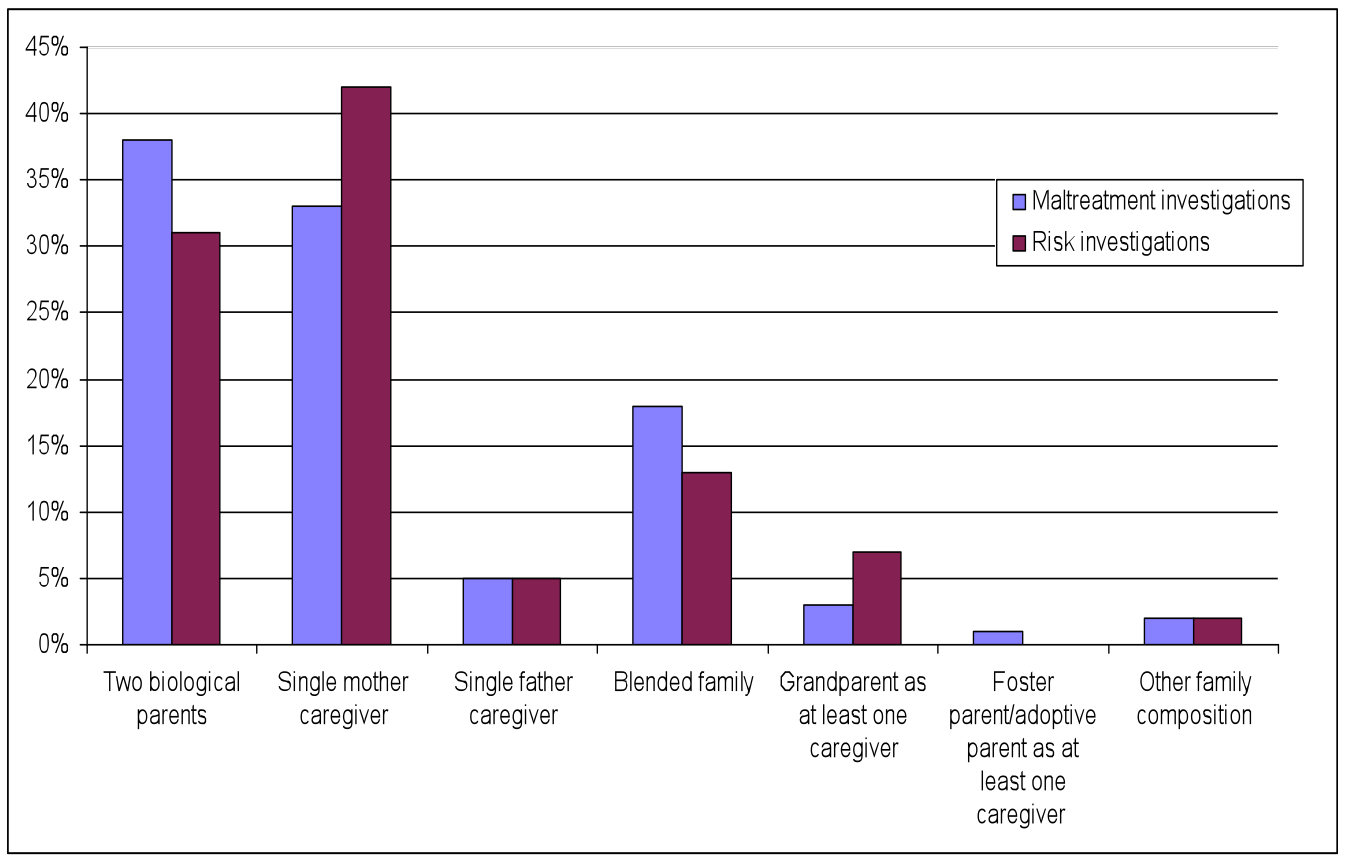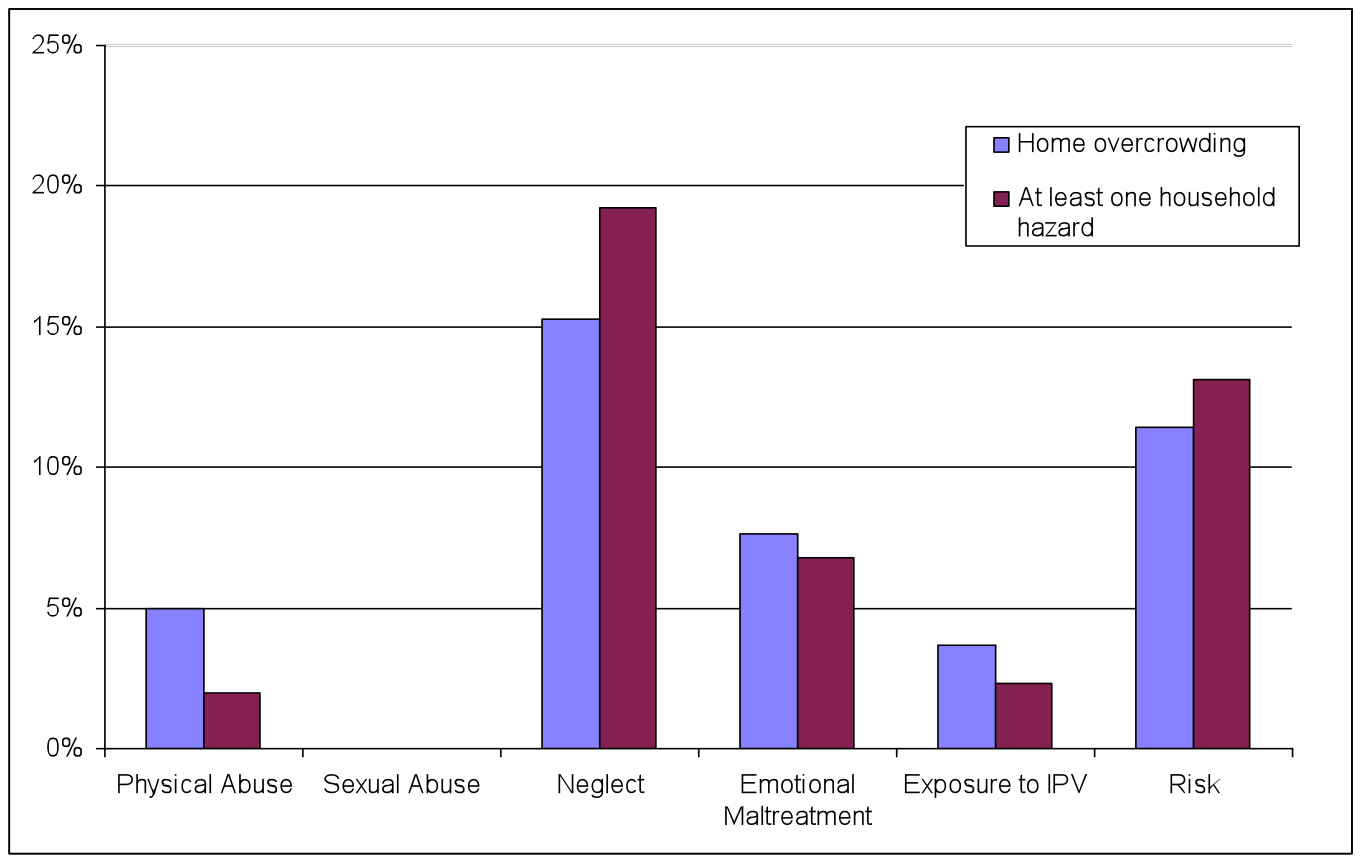CWRP Information Sheet #117E. (2012). Toronto, ON: Faculty of Social Work, University of Toronto.
Introduction
The Ontario Incidence Study of Reported Child Abuse and Neglect, 2008 (OIS-2008) is the fourth provincial study to examine the incidence of reported child maltreatment and the characteristics of children and families investigated by child welfare authorities in Ontario. This fact sheet examines household characteristics and composition in maltreatment-related investigations in Ontario in 2008.
Background to the OIS-2008
From 1998 to 2003, the OIS found that rates of investigated maltreatment had doubled. This pattern may reflect changes in detection, reporting, and investigation practices rather than an increase in the number of children being abused and neglected. Four changes are particularly important to consider: increased reporting by professionals, increased reports of emotional maltreatment and exposure to intimate partner violence, more children investigated in each family, and increased substantiation rates. These changes are consistent with shifts in the context of Ontario child welfare.
Due to changes in investigation mandates and practices over the last 10 years, the OIS-2008 differed from previous cycles in that it tracked both risk-only investigations and maltreatment investigations. Risk-only investigations were those in which a specific past incident of maltreatment was not suspected or alleged to have occurred, but rather a constellation of factors lead to concerns that a child may be maltreated in the future (e.g., caregiver with a substance abuse issue).
Methodology
The OIS-2008 used a multi-stage sampling design to select a representative sample of 23 child welfare agencies in Ontario and then to select a sample of cases within these agencies. Information was collected directly from child protection workers on a representative sample of 7,471 child protection investigations conducted during a three-month sampling period in 2008. This sample was weighted to reflect provincial annual estimates. After two weighting procedures were applied to the data, the estimated number of maltreatment-related investigations (i.e., maltreatment and risk-only investigations) conducted in Ontario in 2008 was 128,748.
For maltreatment investigations, information was collected regarding the primary form of maltreatment investigated as well as the level of substantiation for that maltreatment. Thirty-two forms of maltreatment were listed on the data collection instrument, and these were collapsed into five broad categories: physical abuse (e.g., hit with hand), sexual abuse (e.g., exploitation), neglect (e.g., educational neglect), emotional maltreatment (e.g., verbal abuse or belittling), and exposure to intimate partner violence (e.g., direct witness to physical violence). Workers listed the primary concern for the investigation, and could also list secondary and tertiary concerns.
For each form of maltreatment listed, workers assigned a level of substantiation. Maltreatment could be substantiated (i.e., balance of evidence indicated that the maltreatment had occurred), suspected (i.e., maltreatment could not be confirmed or ruled out), or unfounded (i.e., balance of evidence indicated that the maltreatment had not occurred).
For each risk investigation, workers determined whether the child was at risk of future maltreatment. The worker could decide that the child was at risk of future maltreatment (confirmed risk), that the child was not at risk of future maltreatment (unfounded risk), or that the future risk of maltreatment was unknown.
Findings
There were an estimated 128,748 maltreatment-related investigations conducted in Ontario in 2008, of which 62% involved two caregiver households and 38% involved single caregiver households. Of the 128,748 maltreatment-related investigations, an estimated 87,025 investigations were for an incident of maltreatment and an estimated 41,723 were risk-only investigations. At the end of the initial investigation, 44% of maltreatment investigations were substantiated (38,571 investigations) and in 20% of risk investigations, the worker determined there was a risk of future maltreatment (8,237 investigations).
Just over one third (38%) of the 38,571 substantiated maltreatment investigations and 50% of the 8,237 confirmed risk investigations involved households with a single caregiver. Fifty-six percent of substantiated maltreatment investigations involved families with full time employment as their source of income compared to only 35% of confirmed risk investigations. About one third of substantiated maltreatment investigations (36%) involved families who lived in a purchased home while only 26% of confirmed risk investigations involved families who owned their home.
Figure 1 displays the specific household composition in substantiated maltreatment investigations and confirmed risk investigations. Substantiated maltreatment investigations were more likely than confirmed risk investigations to have two biological parent caregivers (38% vs. 31%) and blended families (18% vs. 13%) while confirmed risk investigations were more likely to have a single mother caregiver (42% vs. 33%) and a grandparent as at least one caregiver (7% vs. 3%). There was a single father caregiver in 5% of both substantiated maltreatment and confirmed risk investigations and “other family composition” in 2% of both these types of investigations. Only 1% of substantiated maltreatment investigations had a foster or adoptive parent as at least one caregiver.
Figure 1: Household composition in substantiated maltreatment and confirmed risk investigations in Ontario in 2008

Household characteristics by primary category of substantiated maltreatment including confirmed risk are shown in Figure 2. Home overcrowding was noted most frequently in substantiated neglect investigations (15%), followed by substantiated emotional maltreatment (8%), confirmed risk (11%), substantiated physical abuse (5%) and substantiated exposure to intimate partner violence (4%). The number of substantiated sexual abuse investigations with noted home overcrowding was too low to be reliably estimated.
At least one household hazard was noted in 19% of substantiated neglect investigations, 13% of confirmed risk investigations, 7% of substantiated emotional maltreatment investigations, and 2% of substantiated physical abuse and exposure to intimate partner violence investigations. The number of substantiated sexual abuse investigations noting at least one household hazard was too low to be reliably estimated.
Figure 2: Household characteristics by primary category of substantiated maltreatment including confirmed risk in Ontario in 2008

Limitations of the OIS-2008
The OIS-2008 does not include information about unreported maltreatment, or cases that were only investigated by police. Reports that were made to child welfare authorities but screened out before they were investigated are not included, and reports on cases currently open at the time of case selection are also not included. The study does not track longer service events that occur beyond the initial investigation.
